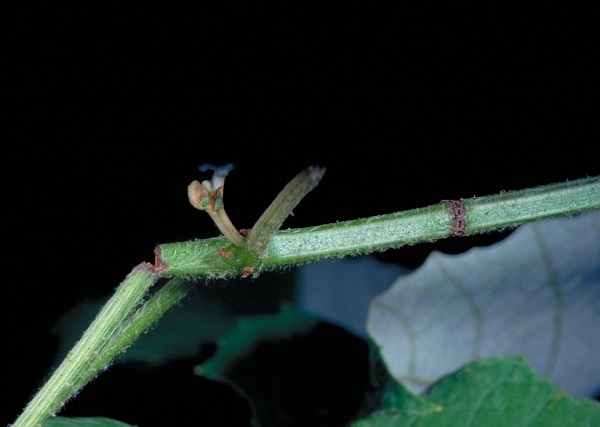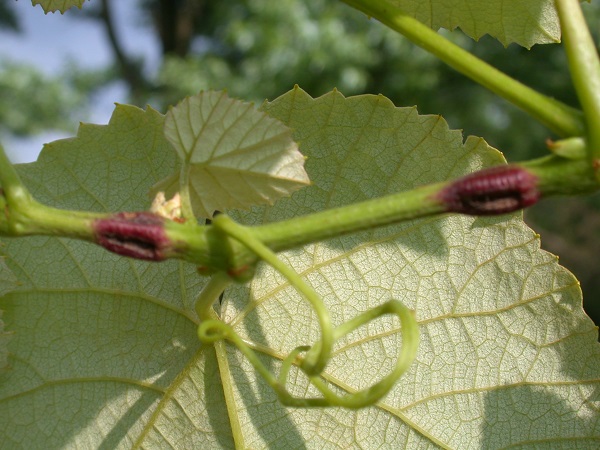Grape Cane Gallmaker and Grape Cane Girdler
ENTFACT-223: Grape Cane Gallmaker and Grape Cane Girdler | Download PDF
by Ric Bessin, Extension Specialist
University of Kentucky College of Agriculture
Grape Cane Girdler
Grape cane girdler is common in central and eastern United States. Adults girdle canes with a row of punctures, that causes canes to break off at the girdled areas. It is only a minor pest on grape, preferring Virginia creeper. Hosts include grape and Virginia creeper.

Figure 1. Grape cane girdler and damage.
The adult is a black snout beetle about 1/8 inch long. The grub is slightly larger when full grown, and is white with a brown head and legless. It is very similar in appearance to the closely related grape cane gallmaker.
Eggs are laid in late spring, around bloom, in a series of holes encircling the cane made by the female using its mouthparts. After eggs are laid, the female continues to make another series of punctures a few inches below the first girdle until the cane is encircled, but eggs are placed only in the holes of the first girdle. A similar girdle is made at a point higher on the cane, causing the end to break. Grubs feed in the cane pith between the girdles. After larval development is completed, pupation occurs. Adults appear in late summer, go into hibernation, and reappear the following spring.

Figure 2. Grape cane girdler damage.
Girdles are usually beyond the fruit clusters and do not cause significant yield loss. Look for broken off, pencil-sized canes with a grub in the pith of each broken off section, or wilted canes with a series of punctures.
Pruning canes a few inches below the lower girdled area is usually sufficient control for this pest. Pruning should be done before adult emergence in late July or August.
Grape Cane Gallmaker
Grape cane gallmaker is a common pest of grapes in Kentucky. This insect produces noticeable red galls on new shoot growth just above nodes. While these are commonly found in vineyards, the majority of the galls are beyond the fruit clusters and usually cause no serious yield loss. Canes with galls are capable of producing a crop the following year.

Figure 3. Grape cane gallmaker adult.
The adult is a dark brown snout beetle about 1/8 inch long and is very similar in appearance to the grape cane girdler. The grub is slightly larger when full grown, and is white with a brown head and legless.

Figure 4. Grape cane gallmaker damage.
In May and June, the female lays an egg in one of a series of holes she chews along the cane just above a node when canes are 10 to 20 inches long. The larva feeds inside the cane which has developed a reddish swelling 3/4 to 1 inch long. The larva becomes fully developed in late July and pupates within the gall. Adult beetles emerge during August and remain in or near the vineyard area, overwintering in trashy borders.
Galls are usually found along vineyard borders near wooded trashy areas or at the ends of rows. If galls will be removed by pruning, it should be done by mid-July before emerging adults exit galls.
Management
As the injury by these pests do not lead to yield reduction, insecticides are usually not needed. Summer pruning can reduce incidence in the future.
Revised: 11/19
CAUTION! Pesticide recommendations in this publication are registered for use in Kentucky, USA ONLY! The use of some products may not be legal in your state or country. Please check with your local county agent or regulatory official before using any pesticide mentioned in this publication.
Of course, ALWAYS READ AND FOLLOW LABEL DIRECTIONS FOR SAFE USE OF ANY PESTICIDE!
Photos courtesy Ric Bessin, University of Kentucky Entomology
